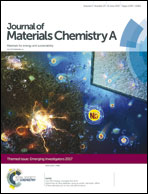Gold nanoparticles-supported histamine-grafted monolithic capillaries as efficient microreactors for flow-through reduction of nitro-containing compounds†
Abstract
A histamine functionalized monolith was synthesized within a micro-sized channel as a permeable support for the immobilization of 5, 20 and 100 nm-sized gold nanoparticles and the resulting nanostructured hybrid monoliths were applied as microreactors for the catalytic reduction of nitro-derivatives. The whole synthetic pathway of the composite materials relies on (i) UV-induced polymerization of N-acryloxysuccinimide and ethylene glycol dimethacrylate in toluene, (ii) surface grafting of histamine through nucleophilic substitution of hydroxysuccinimide leaving groups, and (iii) specific adsorption of citrate-stabilized colloidal gold nanoparticles. The achievement of the successive synthetic steps was ascertained by using a combination of experimental techniques providing information about the chemical composition (FTIR, Raman, and EDX) and porosity and surface-dispersion (SEM) of gold nanoparticles. Of particular interest, it is shown that surface-grafted histamine units exhibit strong affinity towards gold nanoparticles and allow homogeneous and dense dispersion of 5 and 20 nm sized nanoparticles. Consequently, the gold nanoparticle size-dependence of the catalytic activity (conversion of nitro and di-nitro aromatic compounds into the corresponding amino and di-amino-derivatives) was demonstrated, highlighting the utmost importance of controlling the dispersion of nano-catalysts on the support surface, while histamine protonation was also evidenced as a parameter of paramount importance regarding nanogold surface density and thus resulting catalytic activity. Histamine protonation notably allows the generation of electrostatic interactions between citrate-coated gold nanoparticles and thus-formed positive charges at the monolith surface.

- This article is part of the themed collection: Journal of Materials Chemistry A Emerging Investigators


 Please wait while we load your content...
Please wait while we load your content...